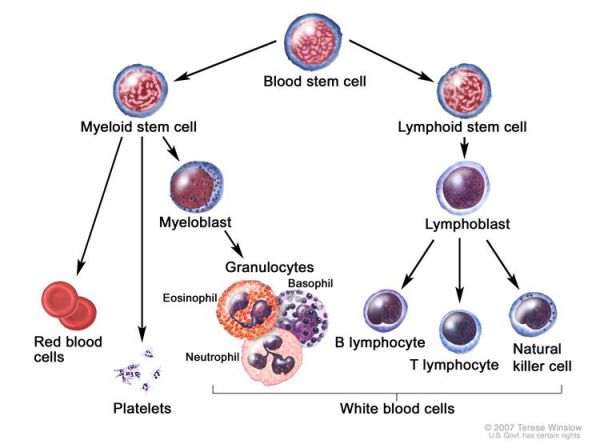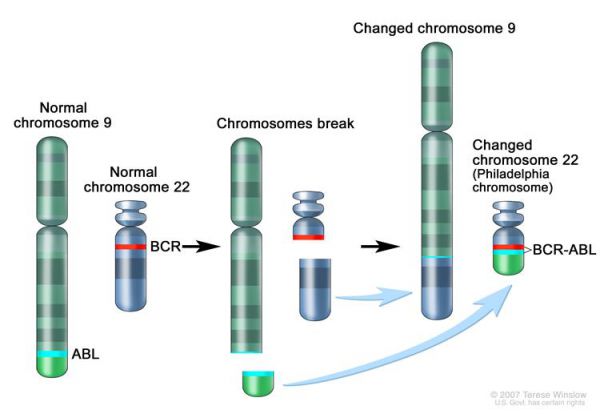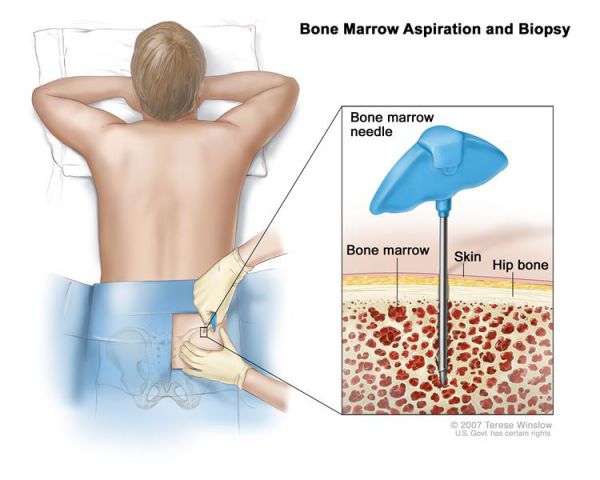Types/leukemia/patient/cml-treatment-pdq
Chronic Myelogenous Leukemia Treatment (PDQ®)–Patient Version
General Information About Chronic Myelogenous Leukemia
KEY POINTS
- Chronic myelogenous leukemia is a disease in which the bone marrow makes too many white blood cells.
- Leukemia may affect red blood cells, white blood cells, and platelets.
- Signs and symptoms of chronic myelogenous leukemia include fever, night sweats, and tiredness.
- Most people with CML have a gene mutation (change) called the Philadelphia chromosome.
- Tests that examine the blood and bone marrow are used to detect (find) and diagnose chronic myelogenous leukemia.
- Certain factors affect prognosis (chance of recovery) and treatment options.
Chronic myelogenous leukemia is a disease in which the bone marrow makes too many white blood cells.
Chronic myelogenous leukemia (also called CML or chronic granulocytic leukemia) is a slowly progressing blood and bone marrow disease that usually occurs during or after middle age, and rarely occurs in children.
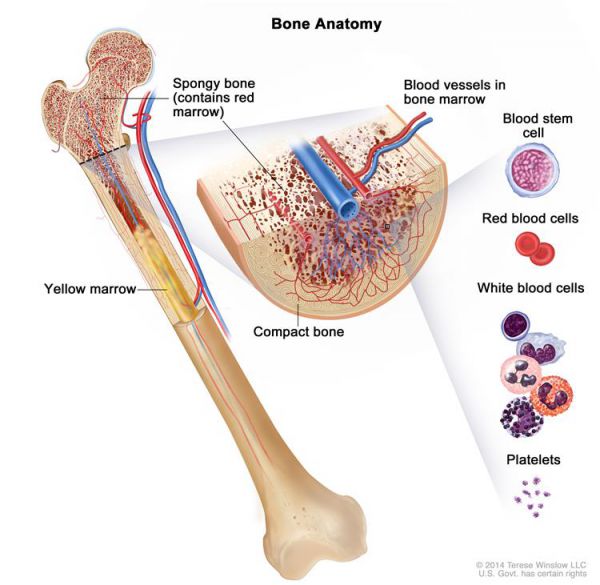
Leukemia may affect red blood cells, white blood cells, and platelets.
Normally, the bone marrow makes blood stem cells (immature cells) that become mature blood cells over time. A blood stem cell may become a myeloid stem cell or a lymphoid stem cell. A lymphoid stem cell becomes a white blood cell.
A myeloid stem cell becomes one of three types of mature blood cells:
- Red blood cells that carry oxygen and other substances to all tissues of the body.
- Platelets that form blood clots to stop bleeding.
- Granulocytes (white blood cells) that fight infection and disease.
In CML, too many blood stem cells become a type of white blood cell called granulocytes. These granulocytes are abnormal and do not become healthy white blood cells. They are also called leukemia cells. The leukemia cells can build up in the blood and bone marrow so there is less room for healthy white blood cells, red blood cells, and platelets. When this happens, infection, anemia, or easy bleeding may occur.
This summary is about chronic myelogenous leukemia. See the following PDQ summaries for more information about leukemia:
- Adult Acute Lymphoblastic Leukemia Treatment
- Childhood Acute Lymphoblastic Leukemia Treatment
- Adult Acute Myeloid Leukemia Treatment
- Childhood Acute Myeloid Leukemia/Other Myeloid Malignancies Treatment
- Chronic Lymphocytic Leukemia Treatment
- Hairy Cell Leukemia Treatment
Signs and symptoms of chronic myelogenous leukemia include fever, night sweats, and tiredness.
These and other signs and symptoms may be caused by CML or by other conditions. Check with your doctor if you have any of the following:
- Feeling very tired.
- Weight loss for no known reason.
- Night sweats.
- Fever.
- Pain or a feeling of fullness below the ribs on the left side.
- Sometimes CML does not cause any symptoms at all.
Most people with CML have a gene mutation (change) called the Philadelphia chromosome.
Every cell in the body contains DNA (genetic material) that determines how the cell looks and acts. DNA is contained inside chromosomes. In CML, part of the DNA from one chromosome moves to another chromosome. This change is called the “Philadelphia chromosome.” It results in the bone marrow making a protein, called tyrosine kinase, that causes too many stem cells to become white blood cells (granulocytes or blasts).
The Philadelphia chromosome is not passed from parent to child.
Tests that examine the blood and bone marrow are used to detect (find) and diagnose chronic myelogenous leukemia.
The following tests and procedures may be used:
Physical exam and health history: An exam of the body to check general signs of health, including checking for signs of disease such as an enlarged spleen. A history of the patient’s health habits and past illnesses and treatments will also be taken.
Complete blood count (CBC) with differential: A procedure in which a sample of blood is drawn and checked for the following:
- The number of red blood cells and platelets.
- The number and type of white blood cells.
- The amount of hemoglobin (the protein that carries oxygen) in the red blood cells.
- The portion of the blood sample made up of red blood cells.
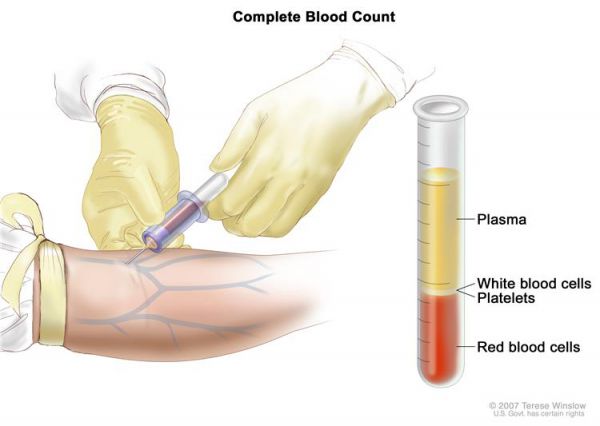
- Blood chemistry studies: A procedure in which a blood sample is checked to measure the amounts of certain substances released into the blood by organs and tissues in the body. An unusual (higher or lower than normal) amount of a substance can be a sign of disease.
- Bone marrow aspiration and biopsy: The removal of bone marrow, blood, and a small piece of bone by inserting a needle into the hipbone or breastbone. A pathologist views the bone marrow, blood, and bone under a microscope to look for abnormal cells.
One of the following tests may be done on the samples of blood or bone marrow tissue that are removed:
- Cytogenetic analysis: A laboratory test in which the chromosomes of cells in a sample of blood or bone marrow are counted and checked for any changes, such as broken, missing, rearranged, or extra chromosomes. Changes in certain chromosomes, such as the Philadelphia chromosome, may be a sign of cancer. Cytogenetic analysis is used to help diagnose cancer, plan treatment, or find out how well treatment is working.
- FISH (fluorescence in situ hybridization): A laboratory test used to look at and count genes or chromosomes in cells and tissues. Pieces of DNA that contain fluorescent dyes are made in the laboratory and added to a sample of a patient’s cells or tissues. When these dyed pieces of DNA attach to certain genes or areas of chromosomes in the sample, they light up when viewed under a fluorescent microscope. The FISH test is used to help diagnose cancer and help plan treatment.
- Reverse transcription–polymerase chain reaction test (RT–PCR): A laboratory test in which the amount of a genetic substance called mRNA made by a specific gene is measured. An enzyme called reverse transcriptase is used to convert a specific piece of RNA into a matching piece of DNA, which can be amplified (made in large numbers) by another enzyme called DNA polymerase. The amplified DNA copies help tell whether a specific mRNA is being made by a gene. RT-PCR can be used to check the activation of certain genes that may indicate the presence of cancer cells. This test may be used to look for certain changes in a gene or chromosome, which may help diagnose cancer.
Certain factors affect prognosis (chance of recovery) and treatment options.
The prognosis (chance of recovery) and treatment options depend on the following:
- patient’s age.
- The phase of CML.
- The amount of blasts in the blood or bone marrow.
- The size of the spleen at diagnosis.
Stages of Chronic Myelogenous Leukemia
KEY POINTS
- After chronic myelogenous leukemia has been diagnosed, tests are done to find out if the cancer has spread.
- Chronic myelogenous leukemia has 3 phases.
- Chronic phase
- Accelerated phase
- Blastic phase
- The patient’s general health.
After chronic myelogenous leukemia has been diagnosed, tests are done to find out if the cancer has spread.
Staging is the process used to find out how far the cancer has spread. There is no standard staging system for chronic myelogenous leukemia (CML). Instead, the disease is classified by phase: chronic phase, accelerated phase, or blastic phase. It is important to know the phase in order to plan treatment. The information from tests and procedures done to detect (find) and diagnose chronic myelogenous leukemia is also used to plan treatment.
Chronic myelogenous leukemia has 3 phases.
As the amount of blast cells increases in the blood and bone marrow, there is less room for healthy white blood cells, red blood cells, and platelets. This may result in infections, anemia, and easy bleeding, as well as bone pain and pain or a feeling of fullness below the ribs on the left side. The number of blast cells in the blood and bone marrow and the severity of signs or symptoms determine the phase of the disease.
Chronic phase
In chronic phase CML, fewer than 10% of the cells in the blood and bone marrow are blast cells.
Accelerated phase
In accelerated phase CML, 10% to 19% of the cells in the blood and bone marrow are blast cells.
Blastic phase
In blastic phase CML, 20% or more of the cells in the blood or bone marrow are blast cells. When tiredness, fever, and an enlarged spleen occur during the blastic phase, it is called blast crisis.
Relapsed Chronic Myelogenous Leukemia
In relapsed CML, the number of blast cells increases after a remission.
Treatment Option Overview
KEY POINTS
- There are different types of treatment for patients with chronic myelogenous leukemia.
- Six types of standard treatment are used:
- Targeted therapy
- Chemotherapy
- Biologic therapy
- High-dose chemotherapy with stem cell transplant
- Donor lymphocyte infusion (DLI)
- Surgery
- New types of treatment are being tested in clinical trials.
- Treatment for chronic myelogenous leukemia may cause side effects.
- Patients may want to think about taking part in a clinical trial.
- Patients can enter clinical trials before, during, or after starting their cancer treatment.
- Follow-up tests may be needed.
There are different types of treatment for patients with chronic myelogenous leukemia.
Different types of treatment are available for patients with chronic myelogenous leukemia (CML). Some treatments are standard (the currently used treatment), and some are being tested in clinical trials. A treatment clinical trial is a research study meant to help improve current treatments or obtain information about new treatments for patients with cancer. When clinical trials show that a new treatment is better than the standard treatment, the new treatment may become the standard treatment. Patients may want to think about taking part in a clinical trial. Some clinical trials are open only to patients who have not started treatment.
Six types of standard treatment are used:
Targeted therapy
Targeted therapy is a type of treatment that uses drugs or other substances to identify and attack specific cancer cells without harming normal cells. Tyrosine kinase inhibitors are targeted therapy drugs used to treat chronic myelogenous leukemia.
Imatinib mesylate, nilotinib, dasatinib, and ponatinib are tyrosine kinase inhibitors that are used to treat CML.
See Drugs Approved for Chronic Myelogenous Leukemia for more information.
Chemotherapy
Chemotherapy is a cancer treatment that uses drugs to stop the growth of cancer cells, either by killing the cells or by stopping them from dividing. When chemotherapy is taken by mouth or injected into a vein or muscle, the drugs enter the bloodstream and can reach cancer cells throughout the body (systemic chemotherapy). When chemotherapy is placed directly into the cerebrospinal fluid, an organ, or a body cavity such as the abdomen, the drugs mainly affect cancer cells in those areas (regional chemotherapy). The way the chemotherapy is given depends on the type and stage of the cancer being treated.
See Drugs Approved for Chronic Myelogenous Leukemia for more information.
Biologic therapy
Biologic therapy is a treatment that uses the patient’s immune system to fight cancer. Substances made by the body or made in a laboratory are used to boost, direct, or restore the body’s natural defenses against cancer. This type of cancer treatment is also called biotherapy or immunotherapy.
See Drugs Approved for Chronic Myelogenous Leukemia for more information.
High-dose chemotherapy with stem cell transplant
High doses of chemotherapy are given to kill cancer cells. Healthy cells, including blood-forming cells, are also destroyed by the cancer treatment. Stem cell transplant is a treatment to replace the blood-forming cells. Stem cells (immature blood cells) are removed from the blood or bone marrow of the patient or a donor and are frozen and stored. After the patient completes chemotherapy, the stored stem cells are thawed and given back to the patient through an infusion. These reinfused stem cells grow into (and restore) the body's blood cells.
See Drugs Approved for Chronic Myelogenous Leukemia for more information.
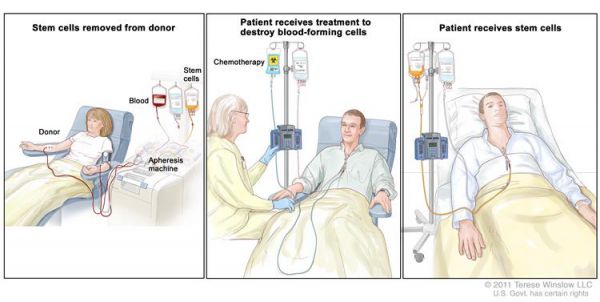
Donor lymphocyte infusion (DLI)
Donor lymphocyte infusion (DLI) is a cancer treatment that may be used after stem cell transplant. Lymphocytes (a type of white blood cell) from the stem cell transplant donor are removed from the donor’s blood and may be frozen for storage. The donor’s lymphocytes are thawed if they were frozen and then given to the patient through one or more infusions. The lymphocytes see the patient’s cancer cells as not belonging to the body and attack them.
Surgery
Splenectomy is surgery to remove the spleen.
New types of treatment are being tested in clinical trials.
Information about clinical trials is available from the NCI website.
Treatment for chronic myelogenous leukemia may cause side effects.
For information about side effects caused by treatment for cancer, see our Side Effects page.
Patients may want to think about taking part in a clinical trial.
For some patients, taking part in a clinical trial may be the best treatment choice. Clinical trials are part of the cancer research process. Clinical trials are done to find out if new cancer treatments are safe and effective or better than the standard treatment.
Many of today's standard treatments for cancer are based on earlier clinical trials. Patients who take part in a clinical trial may receive the standard treatment or be among the first to receive a new treatment.
Patients who take part in clinical trials also help improve the way cancer will be treated in the future. Even when clinical trials do not lead to effective new treatments, they often answer important questions and help move research forward.
Patients can enter clinical trials before, during, or after starting their cancer treatment.
Some clinical trials only include patients who have not yet received treatment. Other trials test treatments for patients whose cancer has not gotten better. There are also clinical trials that test new ways to stop cancer from recurring (coming back) or reduce the side effects of cancer treatment.
Clinical trials are taking place in many parts of the country. Information about clinical trials supported by NCI can be found on NCI’s clinical trials search webpage. Clinical trials supported by other organizations can be found on the ClinicalTrials.gov website.
Follow-up tests may be needed.
Some of the tests that were done to diagnose the cancer or to find out the stage of the cancer may be repeated. Some tests will be repeated in order to see how well the treatment is working. Decisions about whether to continue, change, or stop treatment may be based on the results of these tests.
Some of the tests will continue to be done from time to time after treatment has ended. The results of these tests can show if your condition has changed or if the cancer has recurred (come back). These tests are sometimes called follow-up tests or check-ups.
Treatment Options for Chronic Myelogenous Leukemia
In This Section
- Chronic Phase Chronic Myelogenous Leukemia
- Accelerated Phase Chronic Myelogenous Leukemia
- Blastic Phase Chronic Myelogenous Leukemia
- Relapsed Chronic Myelogenous Leukemia
For information about the treatments listed below, see the Treatment Option Overview section.
Chronic Phase Chronic Myelogenous Leukemia
Treatment of chronic phase chronic myelogenous leukemia may include the following:
- Targeted therapy with a tyrosine kinase inhibitor.
vHigh-dose chemotherapy with donor stem cell transplant.
- Chemotherapy.
- Splenectomy.
- A clinical trial of lower-dose chemotherapy with donor stem cell transplant.
- A clinical trial of a new treatment.
Use our clinical trial search to find NCI-supported cancer clinical trials that are accepting patients. You can search for trials based on the type of cancer, the age of the patient, and where the trials are being done. General information about clinical trials is also available.
Accelerated Phase Chronic Myelogenous Leukemia
Treatment of accelerated phase chronic myelogenous leukemia may include the following:
- Donor stem cell transplant.
- Targeted therapy with a tyrosine kinase inhibitor.
- Tyrosine kinase inhibitor therapy followed by a donor stem cell transplant.
- Biologic therapy (interferon) with or without chemotherapy.
- High-dose chemotherapy.
- Chemotherapy.
- Transfusion therapy to replace red blood cells, platelets, and sometimes white blood cells, to relieve symptoms and improve quality of life.
- A clinical trial of a new treatment.
Use our clinical trial search to find NCI-supported cancer clinical trials that are accepting patients. You can search for trials based on the type of cancer, the age of the patient, and where the trials are being done. General information about clinical trials is also available.
Blastic Phase Chronic Myelogenous Leukemia
Treatment of blastic phase chronic myelogenous leukemia may include the following:
- Targeted therapy with a tyrosine kinase inhibitor.
- Chemotherapy using one or more drugs.
- High-dose chemotherapy.
- Donor stem cell transplant.
- Chemotherapy as palliative therapy to relieve symptoms and improve quality of life.
- A clinical trial of a new treatment.
Use our clinical trial search to find NCI-supported cancer clinical trials that are accepting patients. You can search for trials based on the type of cancer, the age of the patient, and where the trials are being done. General information about clinical trials is also available.
Relapsed Chronic Myelogenous Leukemia
Treatment of relapsed chronic myelogenous leukemia may include the following:
- Targeted therapy with a tyrosine kinase inhibitor.
- Donor stem cell transplant.
- Chemotherapy.
- Donor lymphocyte infusion.
- Biologic therapy (interferon).
- A clinical trial of new types or higher doses of targeted therapy or donor stem cell transplant.
Use our clinical trial search to find NCI-supported cancer clinical trials that are accepting patients. You can search for trials based on the type of cancer, the age of the patient, and where the trials are being done. General information about clinical trials is also available.
To Learn More About Chronic Myelogenous Leukemia
For more information from the National Cancer Institute about chronic myelogenous leukemia, see the following:
- Leukemia Home Page
- Targeted Cancer Therapies
- Drugs Approved for Chronic Myelogenous Leukemia
- Drugs Approved for Myeloproliferative Neoplasms
- Immunotherapy to Treat Cancer
- Blood-Forming Stem Cell Transplants
For general cancer information and other resources from the National Cancer Institute, see the following:
- About Cancer
- Staging
- Chemotherapy and You: Support for People With Cancer
- Radiation Therapy and You: Support for People With Cancer
- Coping with Cancer
- Questions to Ask Your Doctor about Cancer
- For Survivors and Caregivers
